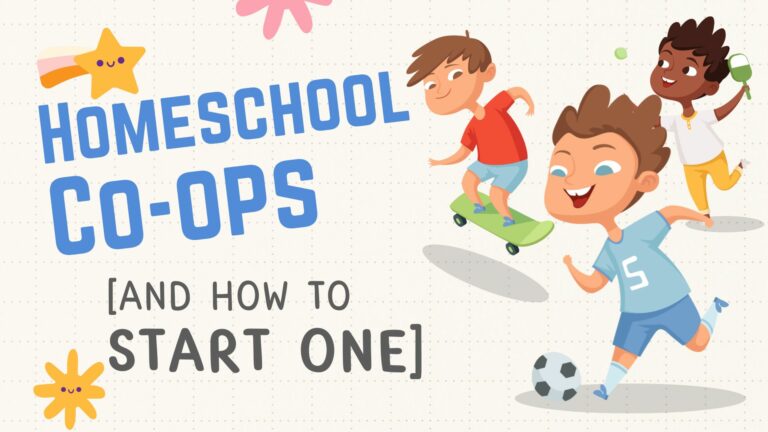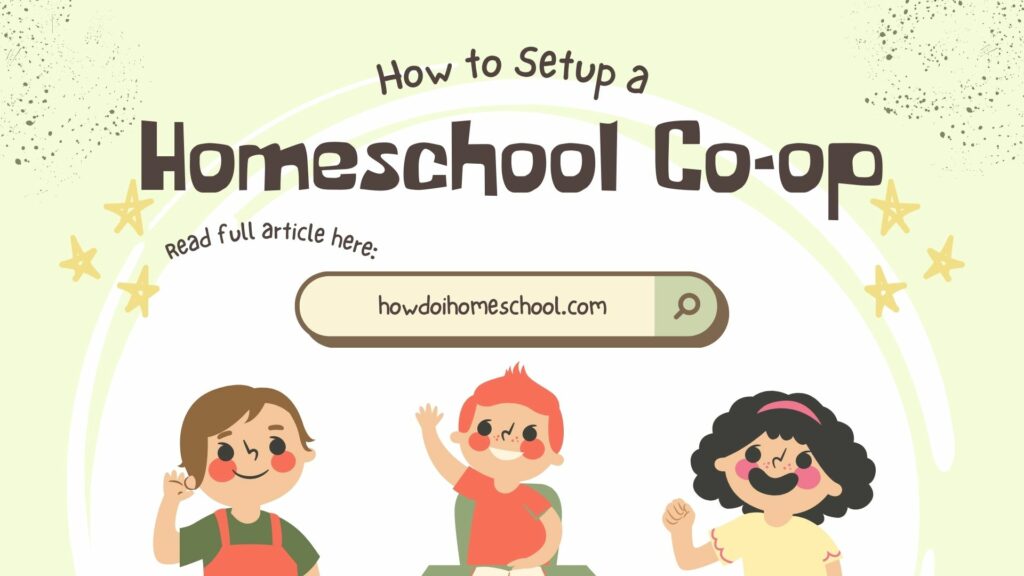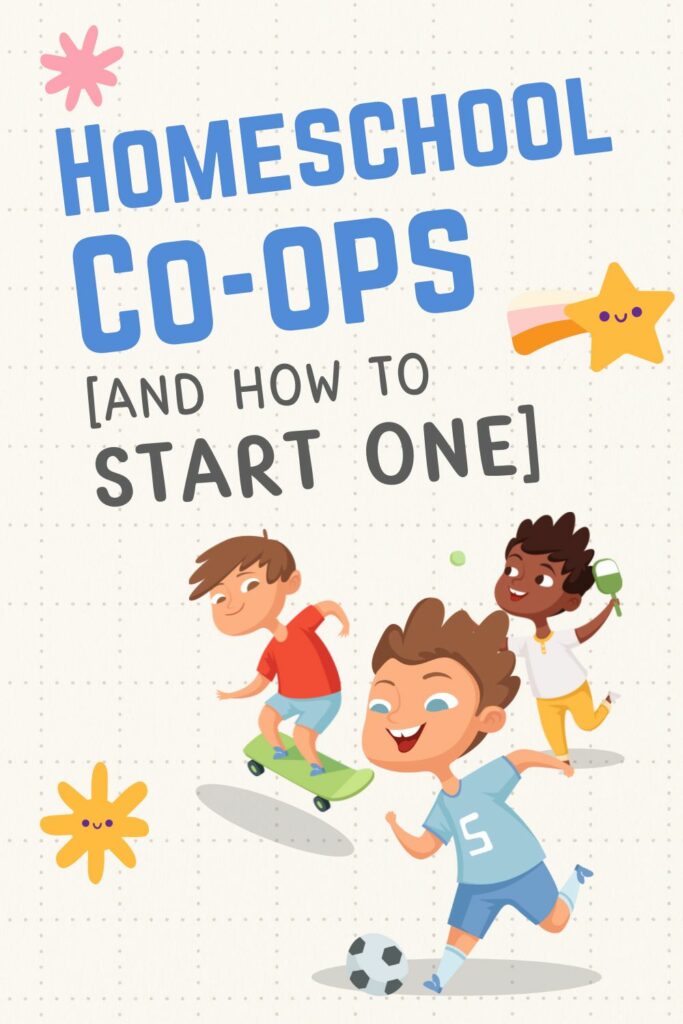If you’ve been homeschooling for a while, you’ve probably heard about homeschool co-ops. A homeschool co-op is a group of families who get together to help educate their kids.

I hope you enjoy reading this blog post. If you want to do my course on how to homeschool, click here.
Some countries, like America, have plenty of co-ops, and parents are spoilt for choice!
Other countries, like Australia, have very few co-ops, and if homeschoolers want to join a co-op, they often have to start a co-op.
So, in this article, we will cover what a homeschool co-op is, the benefits of a co-op, and how you can start one yourself if you don’t have one around you that suits you!
There are affiliate links in this article.
What Are Homeschool Co-ops?
A homeschool co-op is a gathering of families collaborating to reach shared goals. These groups can focus on academics, socializing, arts, activities, crafts, service work, or projects, individually or in combination.
Homeschool co-ops often look very different.
Some are extremely formal and connected with large organizations that use highly structured curricula. Some are informal co-ops created by a couple of families to provide socialization and a bit of fun for their children.
There are also religious co-ops made up of church families that give kids a more in-depth religious education than they might otherwise receive.
Finally, there are also virtual homeschool co-ops – some of which are united around one particular curriculum. These co-ops allow families around the world to collaborate and spur each other on. This, in turn, provides an excellent education for their homeschooled children.
What Is the Purpose of a Homeschool Co-op
The purpose of a homeschool co-op varies significantly.
Some groups primarily focus on giving their children an excellent academic education. Others focus on adding extra fun and socialization opportunities to their children’s week.
Different homeschool co-ops vary widely because the purpose (goals/aims) of the co-op reflects the needs of the families involved in the co-op. That is, families usually look for co-ops that will fill a void in the family’s homeschool life.
For example, one homeschool co-op I was involved with focused solely on the extra subjects that are hard to do at home yourself. In this group, we:
- read and discussed good books,
- enjoyed art lessons from a professional artist,
- and went on nature walks.
The co-op’s goal was to supplement our children’s education and enjoy each other’s company.
Other co-ops are highly academic and designed to help parents provide an excellent education to their children through exceptional tutors, structured classes, and graded tests.
You can also find co-ops that focus on field trips, sports, classical education, Minecraft, nature study, art, music…and just about anything your heart could desire.
How Do Homeschool Co-ops Work?
When you look into homeschool co-ops, you’ll discover they vary dramatically based on the co-op’s leadership, purpose, and organization.
A highly structured homeschool co-op will have a strong purpose, a waiting list, and formal classes for your children to attend. You may need to pay for books and courses.
These structured co-ops sometimes hire a college student to teach the classes.
Other homeschool co-ops encourage the parents to teach subjects they know well. A mom who adores math may teach math classes, while another mom who writes can teach children how to write.
These co-ops tend to be less expensive than other co-ops but will require more time from parents. Instead of handing your children over to be taught several courses by a third party, you’ll need to invest time to prepare and teach some of the classes yourself.
Activities You May Find at Homeschool Co-ops
Homeschool co-ops include a wide variety of different activities. Some co-ops will provide academic courses such as English, languages, and science, while others focus on sports.
Here’s a list of the various activities you may find at your local homeschool co-ops:
- History courses
- Debate teams
- English classes
- Foreign language courses such as French, Latin, German, or Chinese
- Science classes like biology, chemistry, and astronomy
- Science lab courses such as a biology lab or physic lab
- Mathematics
- Gym classes
- Field trips
- Robotic courses
- Nature Study
- Art courses
- Book clubs
- Orchestra or band
- Plays
- Writing
- Film making
As you can see, homeschool co-ops can give children an opportunity to participate in activities that a single family might find difficult to provide by themselves.
What is the Difference Between a Tutorial and a Co-Op?
A tutorial is like a small group or one-on-one lesson where a teacher focuses on specific subjects.
A co-op is when families team up to teach different subjects and activities together.
Tutorials are more personal, while co-ops involve more families working together.
What Does Co-Op Stand For?
Co-op stands for cooperative. This means people work together to get something done.
This is happening in the sense that different families are joining together to make education happen for thier children.
How to Find a Homeschool Co-op?
While you can google your city, state, or province to discover homeschool co-ops in your area, I’ve found the best way is to ask around.
Check to see if there’s a local Facebook homeschool group you can join. Ask the parents there if they know of a co-op you can join.
You can also ask friends and any other homeschool families you meet if they know of homeschool co-ops that you can join.
Another method is to check to see if you can join a virtual homeschool group around your curriculum. I know many users of Tapestry of Grace will participate in a virtual homeschool group. Often the parents will take turns leading the many discussions required by the curriculum.
How to Start a Homeschool Co-op
But what if you can’t find a homeschool co-op in your area? Or the homeschool co-op doesn’t fit your family’s needs?
You can create a homeschool co-op! The advantage to creating a homeschool co-op is you can tailor it specifically to meet your family’s goals, desires, and needs. You won’t need to worry about a co-op that’s not a good fit.
However, this will often require a more significant time commitment to find other families, organize the co-op, and tailor it to your specifications.
What Type of Homeschool Co-op Do You Want to Create
Before you move on, you will first need to know what type of homeschool co-ops you might want to create. Are you looking for help meeting your children’s academic needs? Socialization for kids who rarely see other kids their age?
Would you like your kids to be able to discuss books they’ve read, a concept in history or science, or have lab partners for a science experiment?
Perhaps you’d like another family to help you plan field trips for your children to explore the local community.
Write down everything you’d like in your dream homeschool co-op.
This will ensure you know what you’re looking for before you begin.
Because there’s nothing worse than spending hours starting a homeschool co-op only to discover your family loathes being a part of it.
Talk to Friends and Other Homeschool Families
Once you know what type of homeschool co-op you’d like to form and the kinds of activities you’d like it to provide, start talking to friends about it.
They may be interested in joining your co-op or know someone who’d like to join. Make sure you’re throwing a wide net and asking on social networks and people you know in person.
This will give you the best chance of finding like-minded families to work with.
How to Run the Co-op
Once you have a few families interested in joining your co-op, you’ll need to figure out a few logistics. How formal do you want your co-op to be?
You could write up by-laws and set up a formal agreement. Or you could play it by ear and hope it works out. That sounds discouraging, but it’s not.
For example, the co-op I joined played it by ear.
We chatted at the park while our kids played and never created a formal group. We were simply a small group of 3 or 4 families who met to provide our children with some extra activities to round out our children’s education.
The co-op worked beautifully. We read books, held discussions, went on nature walks, and enjoyed art lessons.
Make sure your co-op fits your needs as you figure out the logistics.
Leadership
It often helps to know who is ultimately in charge of the group. Does each instructor have the freedom to design their own classes? What happens if there’s a conflict of interest?
There’s no one correct answer. I know many groups are run by a community or a single person. Keep in mind that the larger the group, the more critical it is that you have a leader who can handle any conflicts that arise.
Time and Location
When are you going to meet? For my small co-op, this was the most challenging part of the discussion. Everyone had different commitments, activities, and expectations.
You may need to create a spreadsheet to determine the best time for everyone to meet. However, if you’re making the co-op yourself, remember that you can dictate the time and place you’d like the group to meet if needed.
The location is slightly less tricky. Most homeschool co-ops I’ve been involved with have met at someone’s house. They gather in the living room or around a dining room table. It works beautifully for a small group.
A large group will need more room. Check local churches to see if they have a hall or classrooms available for your co-op. Another option is to see if you can rent a community building or shelter each week.
This means that a large group may need the families to split the cost of renting a building for the local co-op to meet.
Members
I can’t tell you how important it is that the members of your co-op get along and have similar needs.
The small co-op I joined had children ranging in age from 7 to 18. The youngest children couldn’t participate in the book discussions the high school teens enjoyed.
They also didn’t have the attention span to enjoy the long and detailed art lessons provided.
However, the group worked.
Only one child came for the art classes and nature walks. The other two small children played while the teenagers and parents discussed books.
But if you’re hoping for a co-op that will provide science labs, in-depth discussions, and detailed art classes, adding a family with only small children to the mix isn’t a good idea. The needs of small children and teens are too different.
By the same token, a co-op based on field trips, gym, and fun activities likely won’t provide the depth desired by teenagers.
So look at the activities you’d like the co-op to provide and choose your members wisely. And don’t be afraid to say no if you think another family won’t be a good fit.
Communication
As you’re setting up the homeschool co-op, decide how you will communicate with each other. Will you organize things in person, through text, or by email? Will you need long phone conversations to get everything set up?
Find the easiest way to communicate as you form your co-op and stick to it. And be willing to arrange to meet in person a few times to hash out the details.
Finalizing Your Homeschool Co-op
At some point, you will need to finalize your homeschool co-op for the semester or school year. Figure out:
- who the members will be
- then, assign a class or topic for the adults to teach
- then, work out what textbooks and supplies will be needed ahead of time.
The better planned you are, the more likely it is that the homeschool co-op will be a success.
And remember that you can make changes as needed throughout the year if you find that one or more of the activities isn’t working for your family.
What to Teach: Homeschool Co-op Class Ideas
So, you know what a homeschool co-op is, and you know how to start a homeschool co-op. The only problem is, you don’t know what to teach!
Well, here are a few homeschool co-op class ideas to get you started:
- Reading
- Paper mache
- Art & messy art projects
- Beading
- Storytelling and drama for little children
- Math art
- Anatomy and physiology
- Woodwork
- Gymnastics
- Cupcake creations
- Knitting, sewing, and crocheting
- Charity projects like Christmas Shoeboxes
- Discuss Proverbs and fables like Aesops
- Geography – Around the world
- Candymaking
- Cooking
- Basket weaving
- Craft projects – there are lots of ideas on Schoolhouse Teachers
- Fitness classes
- Lapbooking
- Magical tricks
- Composers study – Memoria Press do this
- Nature crafts
- History using the Bible
- Patchwork quilting
- Narration and Debating
- Poster making
- Bring a project and explain it to the class
- Weather study
- Calligraphy
- Missionary Heroes
- Researching interesting/disgusting/fascinating topics
- Artist study – Memoria Press do this
- Re-ennacting a scene like a battle or famous historical scene
- Script-writing and acting
- Greek and Roman mythology
- Languages – Spanish, Latin, German etc
- Graphic design
- Peer editing of essays or short stories
- Science experiments
- Cool math games
- Video editing
- Coding
- Scrapbooking
- STEM classes
- Music study
- Music Appreciation
- Scouts/Girl guides (something similar)
- Nature walks
- Field trips to museums, zoos, and other interest areas
- Current event analysis
- Economics (here are some economics curriculum programs)
- Electrical projects
- Logic
- How to understand the Bible
- Great prayers in history
- Great study skills
- World religions
Camping
Don’t forget to include an annual or bi-annual camping trip on your homeschool co-op schedule. It will help draw your group together and help you get along more!
Conclusion
A homeschool co-op can be a fantastic resource to help you educate your children. Before you jump into a co-op, make sure you know what you’d like the co-op to provide for your family, whether that be help with socialization, field trips, or academics. Because homeschooling is a challenge.
If you’d like more advice or help getting started homeschooling, check out the How to Homeschool Course. You’ll discover all the tips and tricks you need to know to start homeschooling without pulling out your hair!






I live in Madison Oh and need to find a homeschool co-op in my area. If you know of anyone please send me the link. Thank you very much.